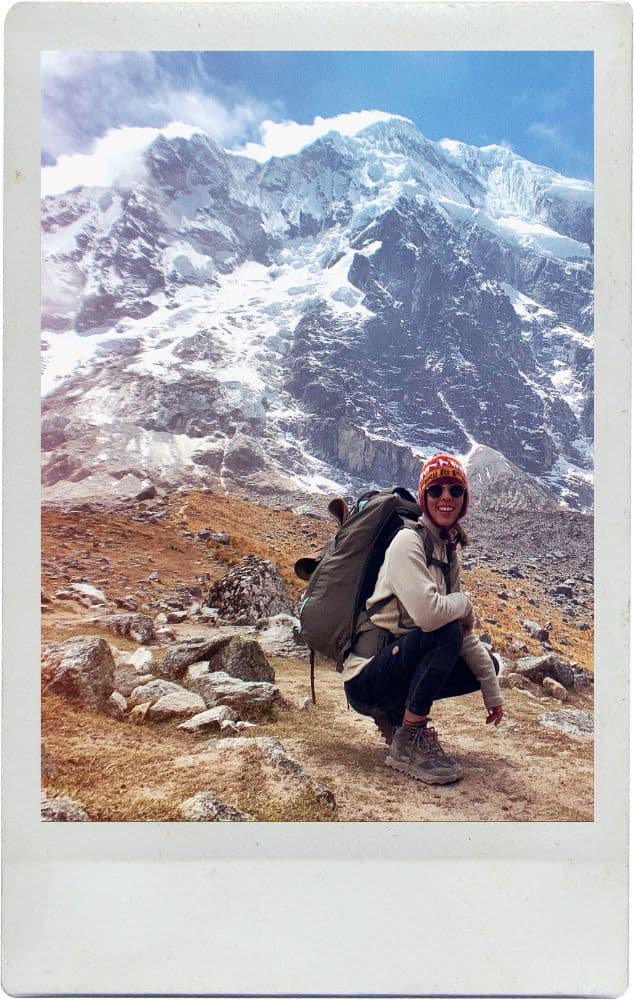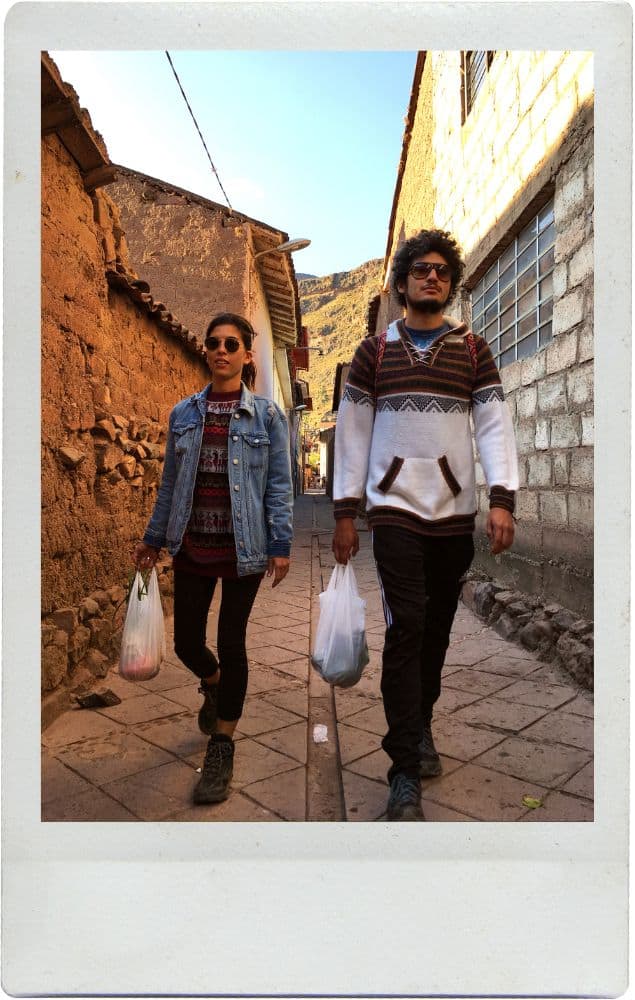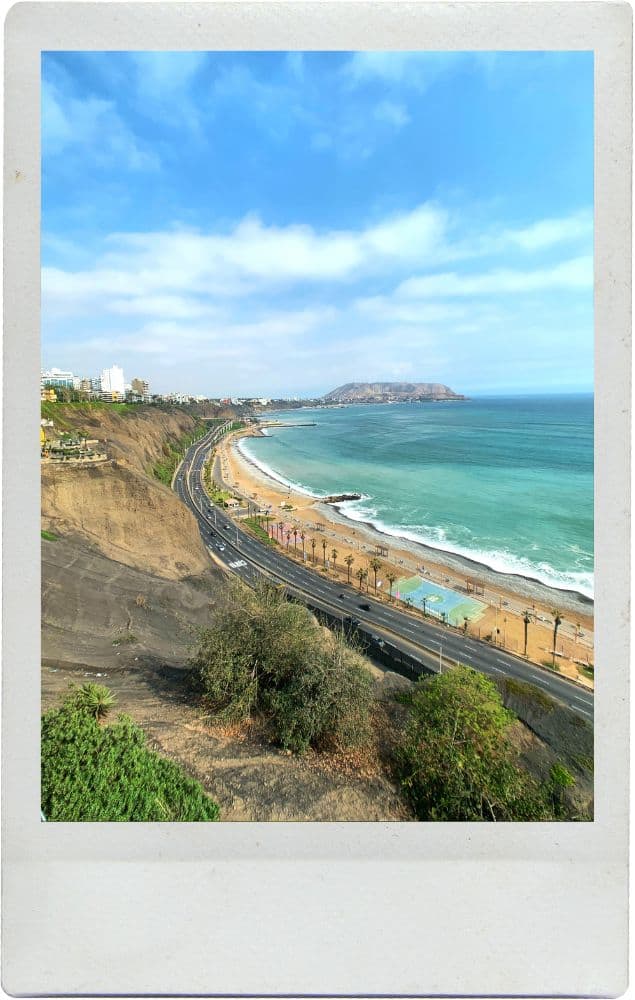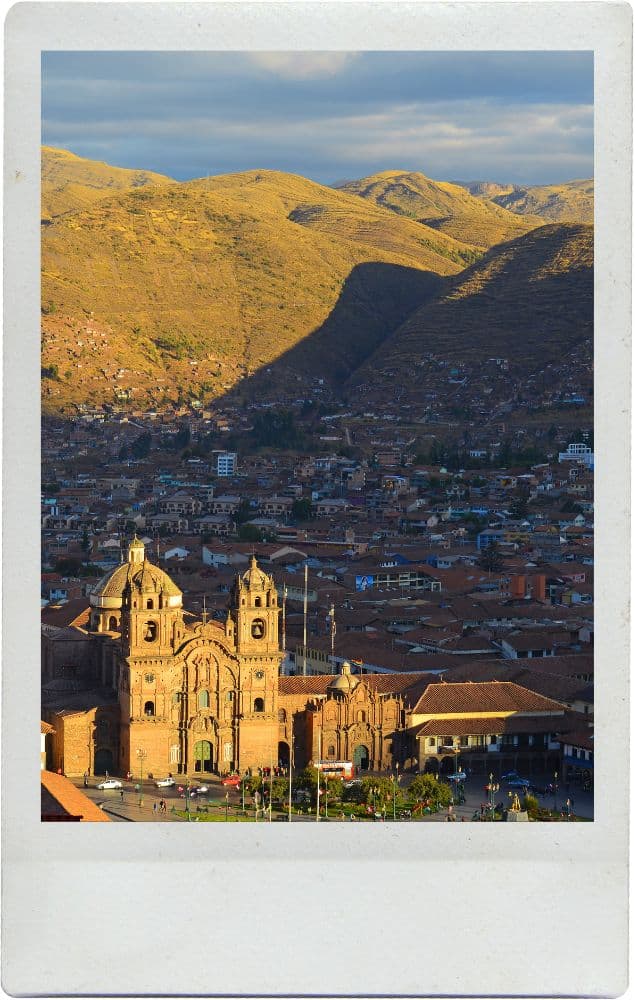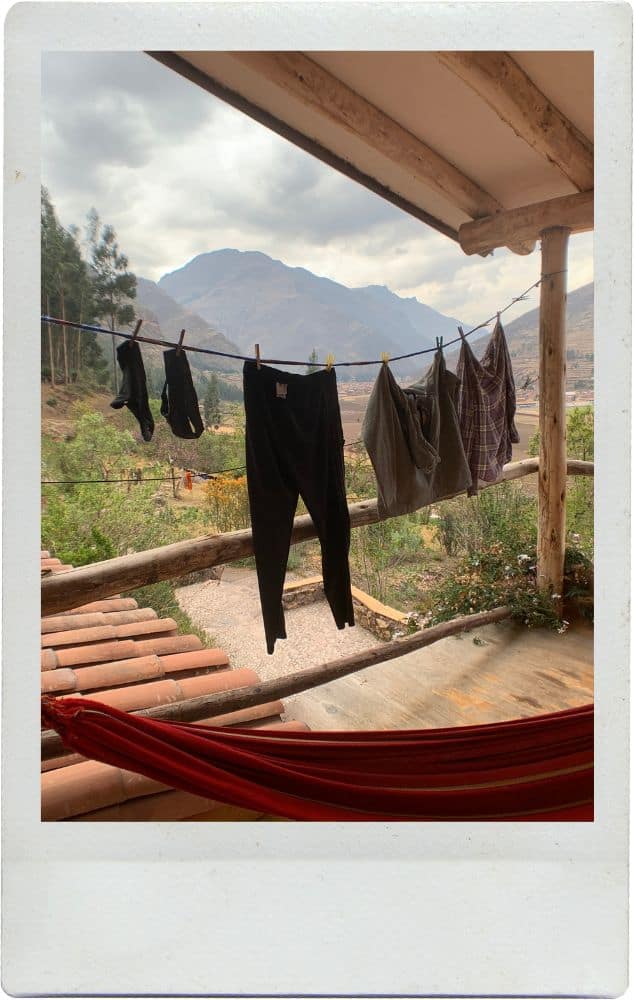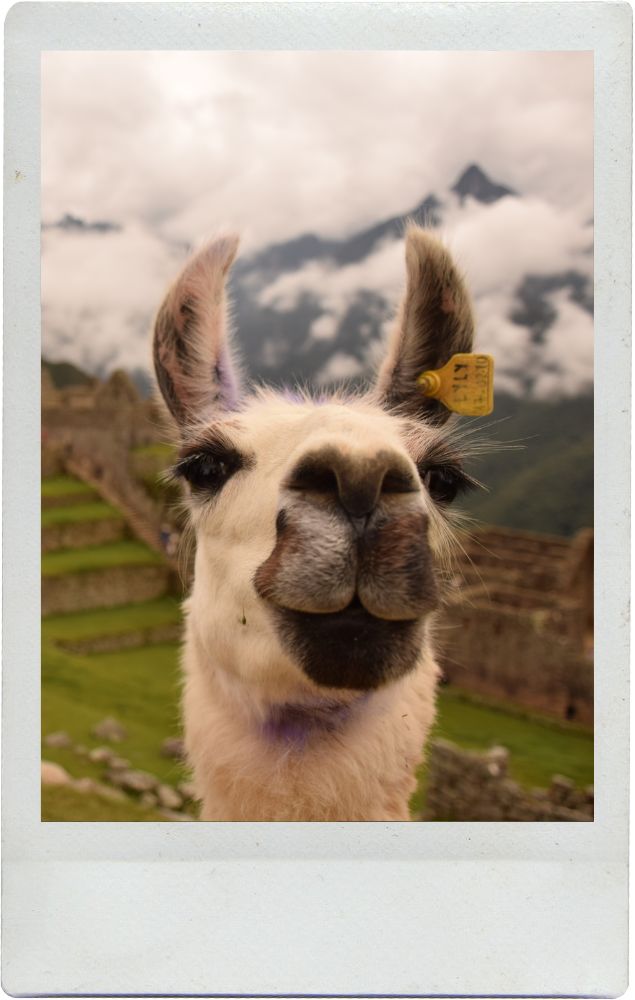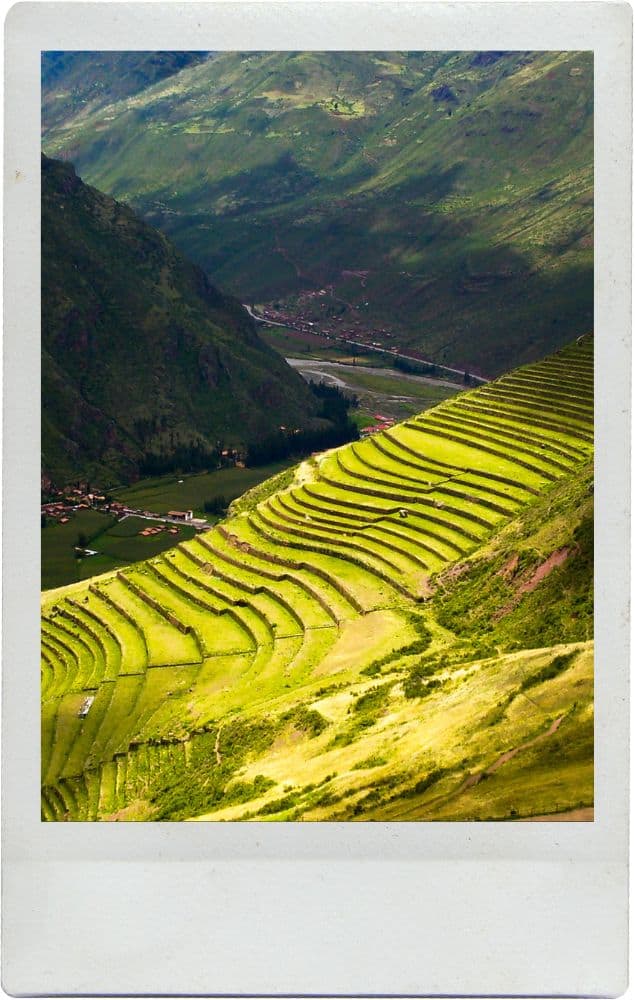5-Day Salkantay Trek to Machu Picchu: What to Expect & Why It’s Worth It
I chose the Salkantay Trail in Peru because it didn’t require a permit or a guide—unlike the famous Inca Trail, which demands both, along with a higher price tag. I wanted something raw and minimal. Just me, my pack, and the silence of the mountains. While part of me would’ve loved to hear stories from a guide about Incan history and mythology, there was something deeply appealing about finding my own way.
We had just finished exploring the Sacred Valley—wandering the ancient terraces and colorful market of Pisac, still carrying the energetic residue of our ayahuasca ceremony in Urubamba. That valley softened us, opened us, and prepared us in ways we didn’t fully understand until we stepped into the high altitudes of the Salkantay Trail of Peru.
7 Things to do in Pisac, Peru: The Gateway to the Sacred Valley
Ayahuasca & Mescaline: 5 Nights in the Heart of the Peru
I didn’t make this journey alone. I hiked the trail with my friend Steven and my ex, who I had broken up with just two weeks before the trip. It wasn’t easy, walking into something so intense with a shift in our relationship still fresh, but we had already committed to the journey—and we honored that.
There was an unspoken agreement between us: to show up with kindness and presence, and not let anything get in the way of the experience. Steven was the glue between us, holding space with a calm energy that made room for both tension and laughter. He never let it feel awkward or heavy, and for that, I’m endlessly grateful.
I mostly spent my time walking beside Steven, and in those quiet hours, something healing happened. The trail didn’t erase the past, but it softened it. And honestly, the trip wouldn’t have been the same without the three of us. We needed each other, in different ways, to fully experience what this trail had to offer.
I had done plenty of research beforehand, but still—I didn’t know what to expect. There are no clear maps online, and I was honestly afraid I’d get lost. The trail is known for being the toughest route to Machu Picchu, with its highest point reaching 15,200 feet (4,650 meters) at the Salkantay Pass. That altitude alone is enough to humble even experienced hikers. But I’ve come to believe that if you have the heart for it, anyone can complete this journey.
And what a journey it is. The beauty of Peru’s Salkantay Trail is almost indescribable. One day you’re walking beneath a snow capped mountain, with the air crisp and biting, and then next you’re descending into the lush humidity of the Amazon rainforest. You pass through quiet villages and farmlands where mangoes, avocados, and coffee grow in abundance. It’s the kind of landscape that shifts and breathes with every step—a place that feels alive in a way that cities never do.
For me, it was the perfect solitude. A retreat from the noise of the world. A kind of pilgrimage, not just to Machu Picchu, but inward—toward myself.
And when we finally arrived at the Sun Gate, when Machu Picchu came into view, I was overwhelmed—not by the ruins themselves, but by what it took to get there. The blisters, the altitude, the doubt, the silence, the awe. That moment carved something into me. Something ancient. Something clear.
It’s true what they say: it’s not the destination. It’s the journey.
Day 1: Getting to the Trail Head
Cusco -> Mollepata -> Soray -> Humantay Lake -> Salkantaypampa
We left Cusco in the early morning, the city still draped in shadows and cold breath. Our taxi took us as far as Mollepata, a small town nestled at the edge of the Andes. He wouldn’t go further—beyond that point, it felt like we were stepping out of the world we knew.
In Mollepata, we had a modest breakfast and managed to find a local who offered to drive us the final hour to Soray. That drive twisted upward through narrow roads, the air thinning with every curve. There, at the Salkantay Lodge, we dropped our packs and made our first ascent—to Humantay Lake.
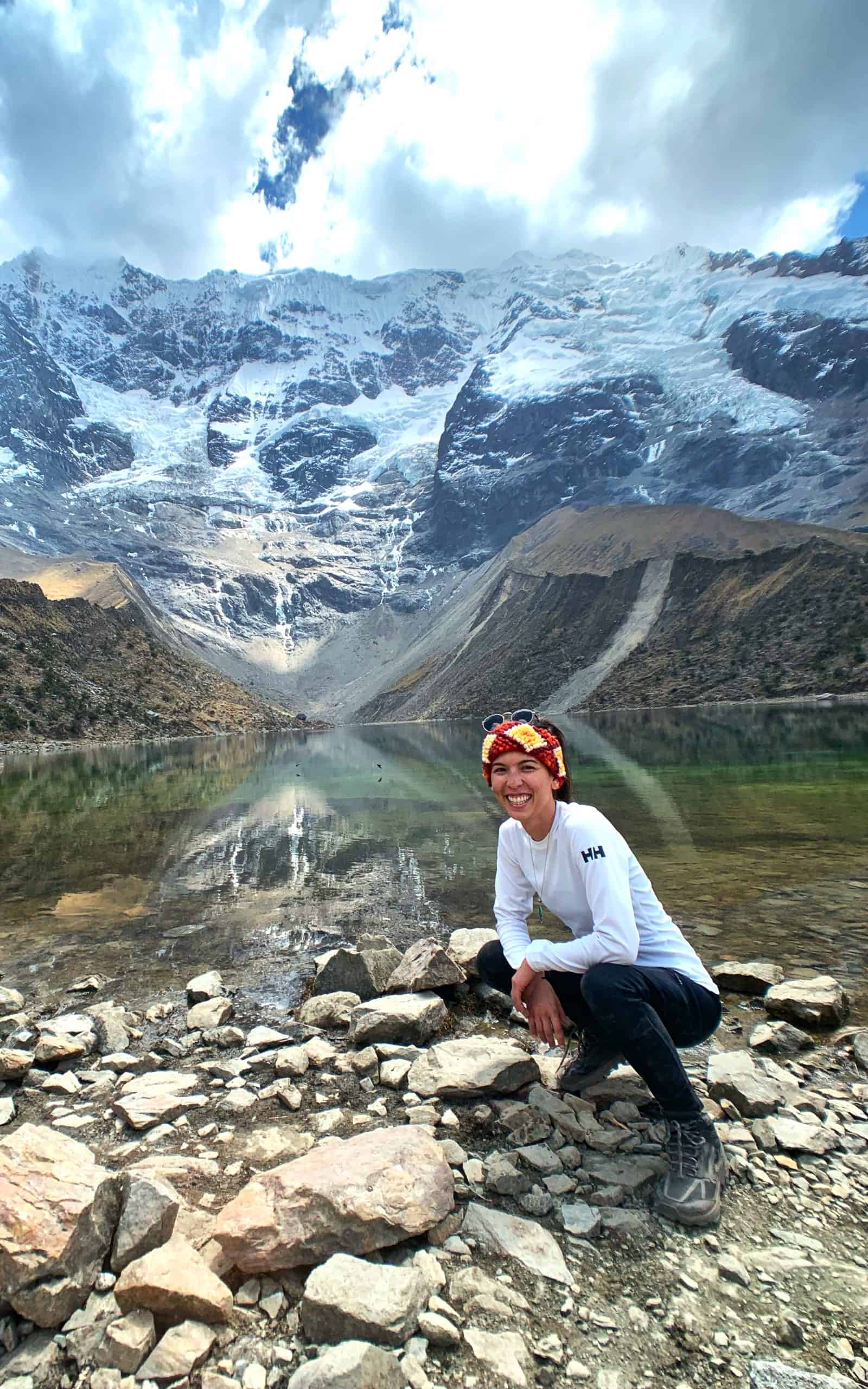
The hike to Humantay Lake was no small feat—it climbed sharply, winding through loose gravel and high-altitude breathlessness. We were lucky not to be carrying our full packs; even without them, the trail demanded our focus.
As we climbed, the mountains began to open like a curtain, revealing glimpses of glacier-blue sky between craggy peaks. When we finally arrived, the view was otherworldly. Humantay Lake, fed by the glacial melt of the towering Humantay Mountain, sat like a mirror cupped in the hands of the Andes—its waters an impossibly vibrant turquoise that seemed almost lit from within.
A handful of people stood quietly around its edge, some in awe, some in prayer, some just letting the silence sink into their bones. The air felt holy. There was something ancient and still there, like the lake remembered everything long before we arrived. We lingered as long as the cold would allow, trying to soak in the stillness before descending.
We hiked back down to the Salkantay Lodge, retrieved our packs, and with the last light slipping down the mountain, we officially began our ascent onto Peru’s Salkantay Trail. The hike was steep, unrelenting, and more exhausting than we expected. But when we reached the lake, it was like standing inside a dream. The turquoise water shimmered beneath the jagged glacier that loomed above it. Everything was still. Sacred. It was our first real glimpse of the power this land held. After descending, we grabbed lunch and began the true trek—our first steps onto the Salkantay Trail of Peru.
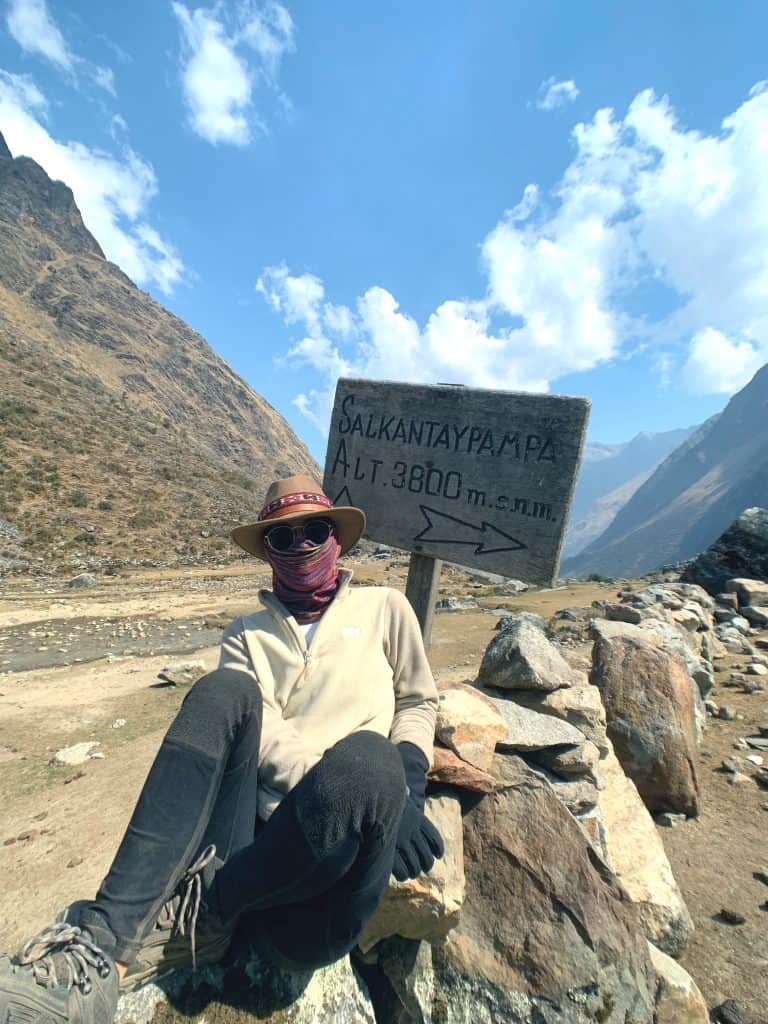
We hadn’t gone far when the trail hit us with its first lesson: humility. A brutal, steep hill rose before us, and after already spending so much energy hiking to Humantay Lake, we were running on fumes. The air grew colder with each step. At the top, we arrived to Salkantaypampa, where the wind howled like it had never been quiet. We found a wall of stones and collapsed beside it, exhausted, watching the sun begin to bleed into the mountains. We were cold, uncertain, and honestly, a little overwhelmed.
And then came laughter.
Peeking over the rocks was a small boy—an indigenous child no older than six—grinning at us through the wind. His pants were torn, cheeks raw from the cold, bare feet pressed into the earth. A giggle escaped as he ducked, then reappeared suddenly in front of us, as if materializing out of the stone itself. Without a word, he kicked a worn soccer ball toward us with a smile. His eyes said the rest: play with me.
So we did.
There, on that remote stretch of earth—beyond exhaustion, beyond altitude—we kicked a ball through the wind with a little boy who knew nothing of our journey, but offered us joy without hesitation. We hadn’t made it far on the trail, but it didn’t matter. We pitched our tent right there, beside the rocks and the boy.
As we prepared our freeze-dried food, he offered us bread—bread his family had made in the small hut nearby. We tried to decline, unsure if they could spare it, but he insisted. We bought all the bread they had, partly out of gratitude, partly out of awe. The hut he pointed to was maybe 8×8 feet, and he told us six people lived inside. It was hard to wrap our minds around. Six lives, one tiny room, and still—hospitality, laughter, warmth.
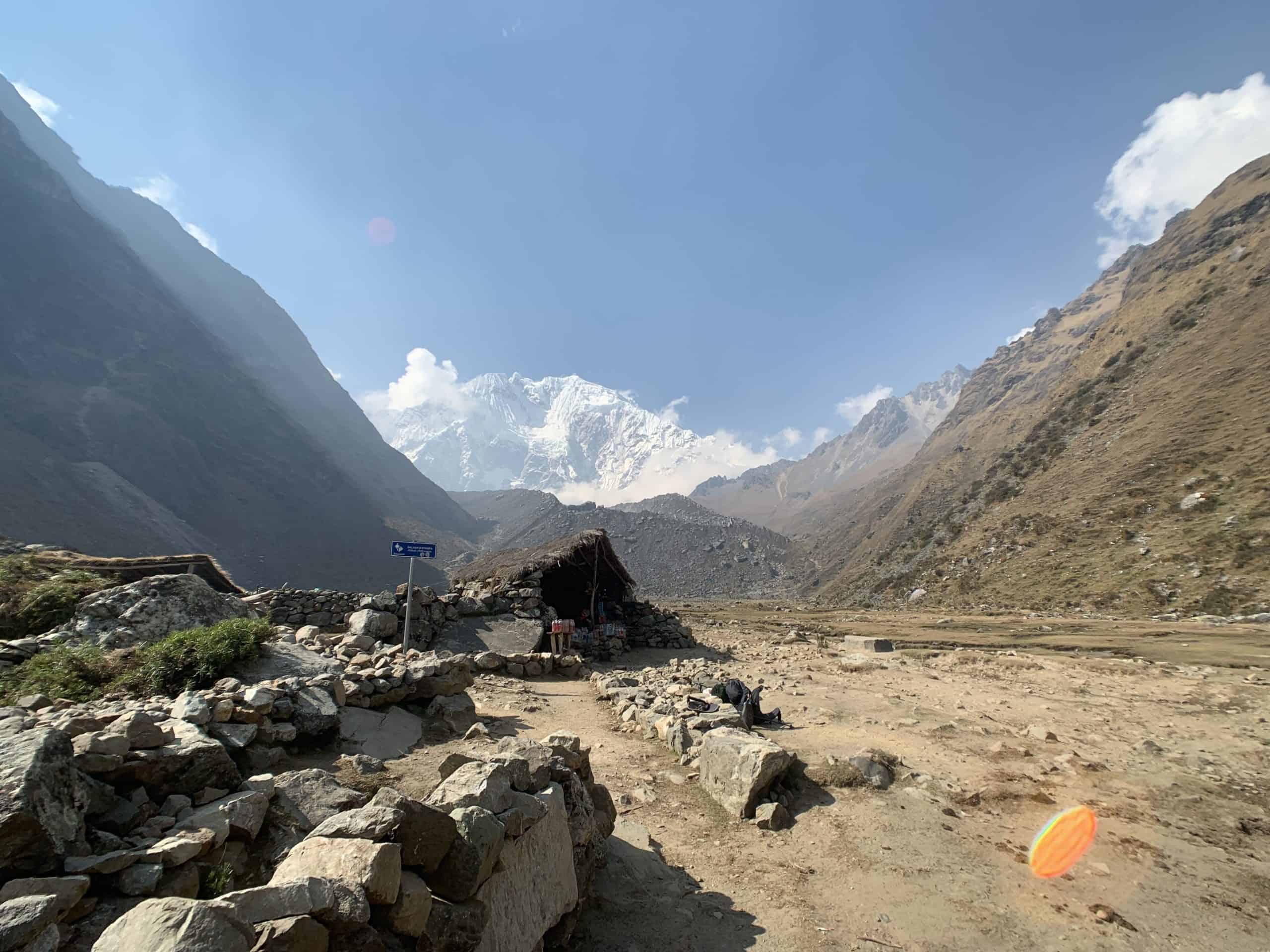
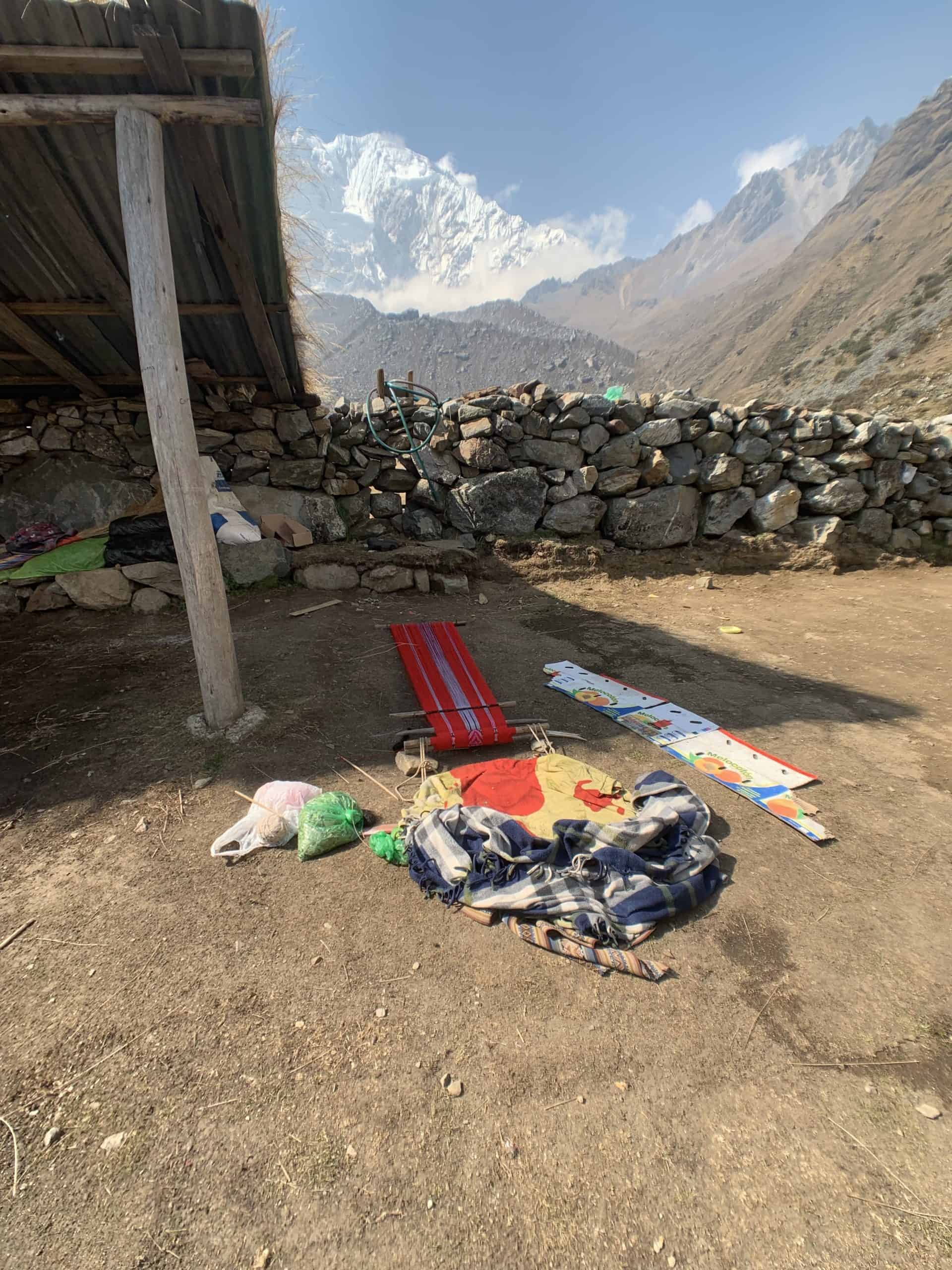
That night, wrapped in cold and silence under the wide Andean sky, I realized something: we travel to see beauty, but what transforms us are the moments of simple, human connection. The boy’s joy, his generosity despite having so little, the way he invited us into his life without hesitation—these things changed the trail for me.
Sometimes, the profound isn’t in the grandeur of a snow peaked mountain or the mystery of ancient ruins. Sometimes, it’s in a child’s laughter carried on the wind, barefoot still chasing a ball, in the bread offered without reason.
We hadn’t gotten far that day, but something inside us had already begun to shift.
Day 2: Salkantay Pass
We woke up slow, sore, and cold. The sun had already begun to warm the frost off the stones when a group of about twenty German hikers walked past our tent, light on their feet and lighter in their loads. I figured they were just beginning their trek, fresh on Day 1, their backpacks nowhere in sight—carried instead by mules that followed at a distance. A part of me felt a twinge of regret. There was something tempting about the ease of it.
But this path was a choice—one that meant carrying my own weight. Weeks had gone into researching lightweight gear, packing only the essentials, investing in tools that would last well beyond the trail. Ease wasn’t the goal; presence was. Backpacking, after all, was something I loved—not just the act of walking, but the ritual of preparation, the intimacy of knowing exactly what you carry and why. To fill in the gaps, we’d rented some gear in Cusco.

We said goodbye to the boy—the soccer, the bread, his laughter echoing like a soft bell behind us—and continued down the trail. The air was thick with fog, each step forward like walking through breath. Eventually, we came upon the Sky Camp, something I had seen during my late-night research sessions: a luxury dome experience tucked into the mountainside, complete with glass ceilings to see the stars. It was beautiful—otherworldly, really—but at $280 per night per person, far beyond what I could justify. Still, it felt like something from a dream, an oasis in the cold.
Then the real work began.
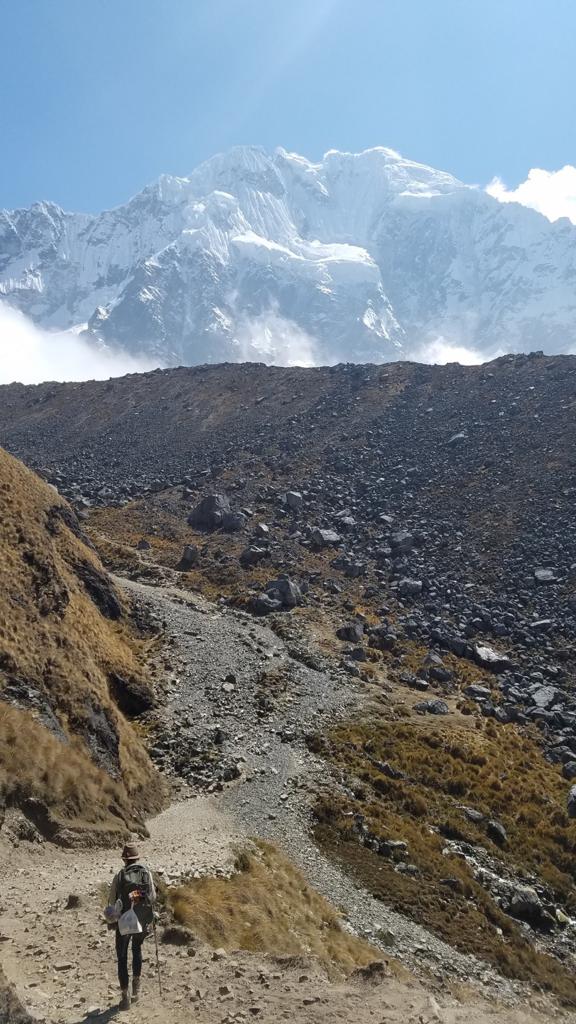
The Salkantay Pass—the highest point on the trail—stood ahead like a challenge whispered by the gods. Switchback after switchback, we climbed, altitude tugging on every breath, turning our lungs into tiny sieves. The air got thinner, our steps slower. Something shifted in my ex. He surged ahead—maybe to beat the mountain, maybe to find space. Steven and I stayed back, climbing slowly, pausing every few steps to catch a breath that never seemed full.
At some point, we stopped. No words were spoken—we were too tired, too raw. We just looked at each other, eyes heavy, hearts thudding under fleece layers. Then Steven reached into the side pocket of his pants and pulled out a small blue package.
Chips Ahoy.
I chuckled lightly, saving my energy, breathless and surprised. I had no idea where he’d gotten them. He grinned, that kind of grin that only comes when you know you’re both on the edge. He opened the package, offered me a cookie, and we sat there, halfway to heaven, sharing factory-made sweetness like it was communion.
We didn’t speak a word.
And somehow, that silence held everything: exhaustion, gratitude, absurdity, presence. It was a moment suspended in time. Just the sound of the wind brushing the mountain, the snow glistening on Salkantay’s peak of Peru, and two friends sharing something so small it became enormous. In a world where everything is loud and fast and insistent, that moment whispered: this is enough.
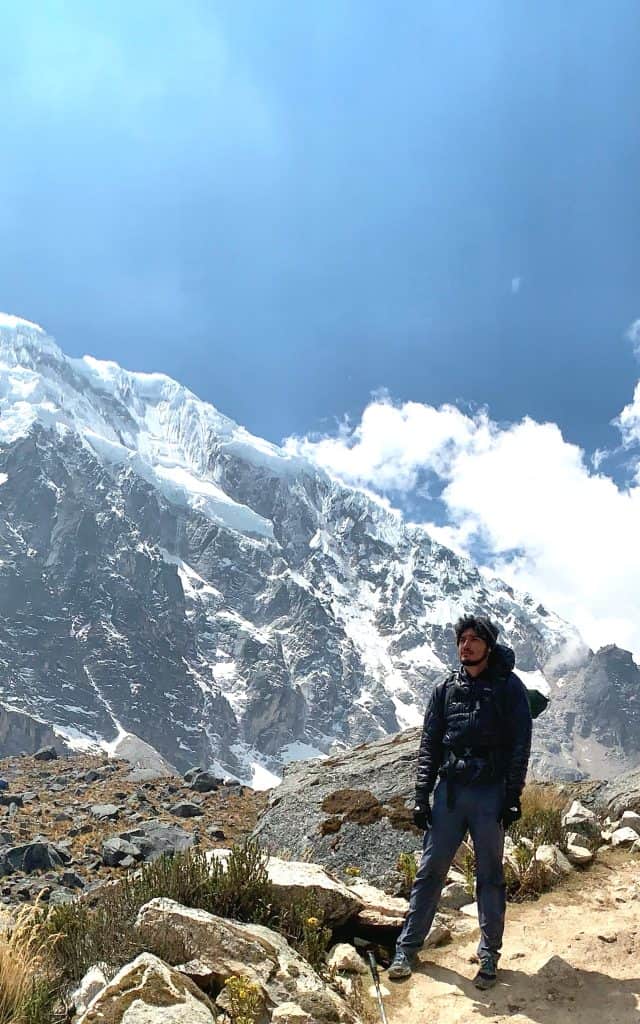
Steven wasn’t just a friend—he’d been a roommate seven years earlier, during one of the most defining, life-altering moments: a near-death experience.
It didn’t happen in a hospital. Not on a distant road. It happened at home—in the bedroom we shared. His home, too. A place that should have been ordinary, safe, unremarkable. But instead, it became the threshold. The place where a body was left behind, where something crossed over and glimpsed the eternal.
The afterlife.
An expanse of overwhelming bliss and silence, beyond time.
And somehow, there was a return.
Steven was there in the days that followed. Quietly present. Not just witnessing the aftermath, but sharing the strange, invasive aftermath of such an unthinkable event unfolding within the walls of the home we shared. That alone creates a bond you can’t put into words.
Just a week before this hike, Steven and I had been in Urubamba, drinking ayahuasca together. Myself, searching for death again, maybe. Or peace. Or clarity. I wanted to understand why I was shown what I was shown. Why I was sent back. Why it never left me.
And now, here I was—in the Andes, breathless and hollowed out by altitude, eating Chips Ahoy with Steven like nothing had happened, and yet somehow knowing everything had. The absurdity and the beauty of it coexisted in that silence. We didn’t speak. We didn’t need to.
In that stillness, I felt it again—not death, not euphoria, but life. The sacred kind. The kind that tastes like cookies in the cold and the sound of cold ground cracking underfoot.
This moment happened because I was given another chance to live.
And this—this is what I mean when I talk about the human experience. It’s not always epiphany. It’s not always light streaming through the veil. Sometimes, it’s just surviving something you weren’t supposed to survive… and ending up here, years later, with a friend who was there, who remembers, and who offers you a cookie at 15,000 feet above sea level.
I’m still here.
Eventually, we stood again, bodies aching, and pushed toward the summit. Step by step, we climbed until we reached the top of the trail—15,200 feet, the highest point on the Salkantay of Peru. We were above the world, above the noise, above the ache. We took photos—because we had to. But no photo would ever capture what the Chips Ahoy did.
And maybe that was the real summit. Not the mountain, but the stillness it demanded. The friendship it revealed. The way it made room for something sacred to unfold between breaths.

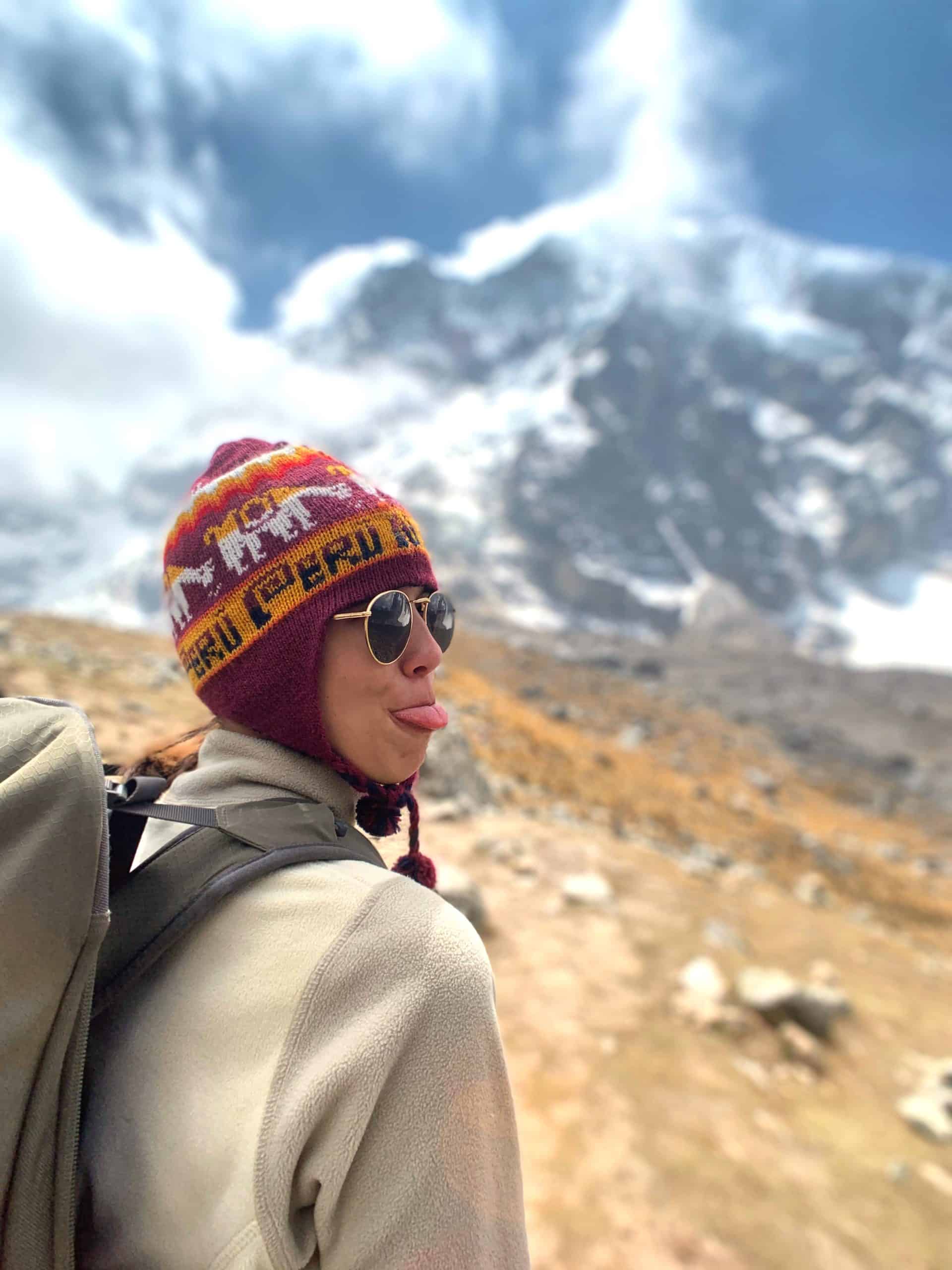
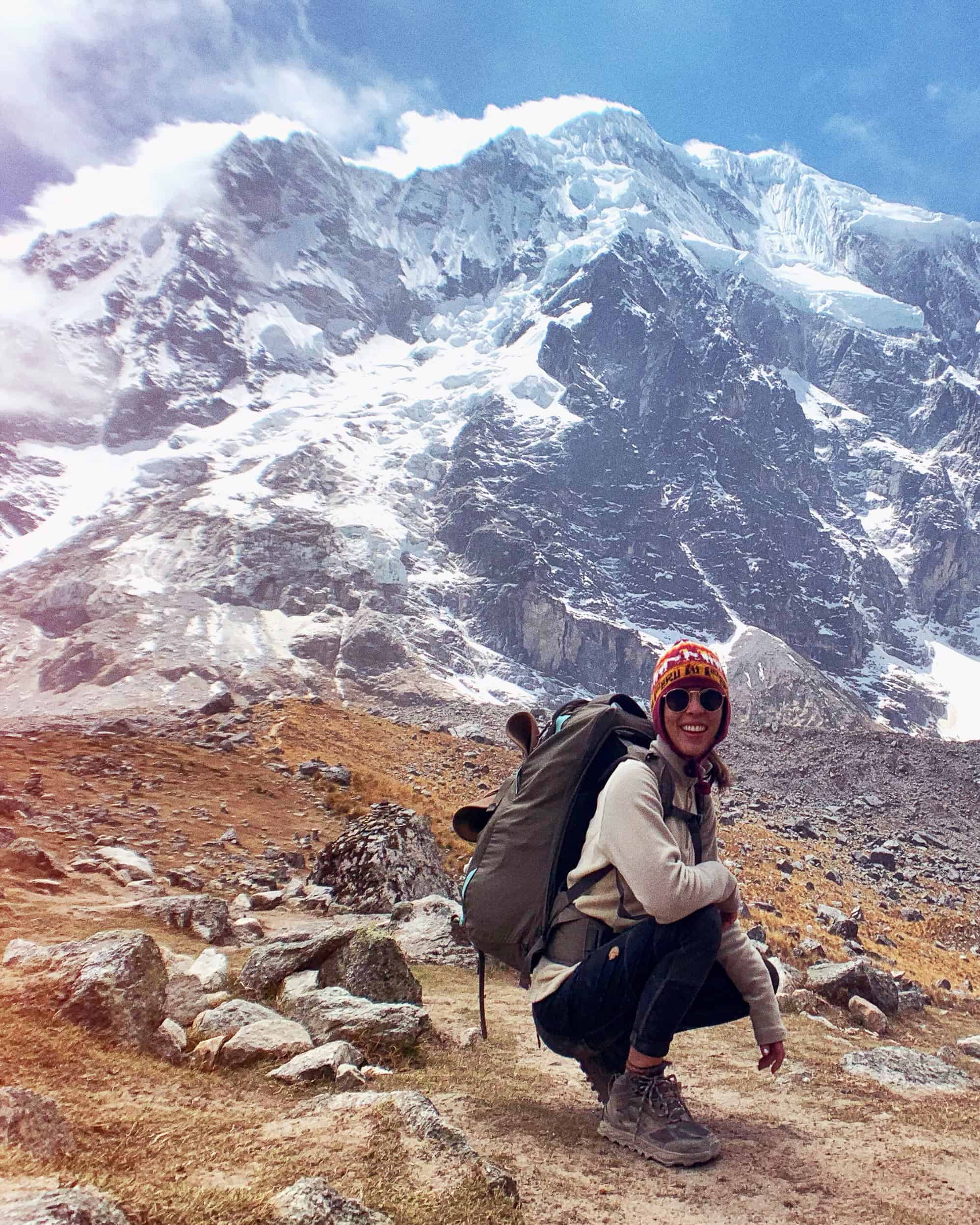
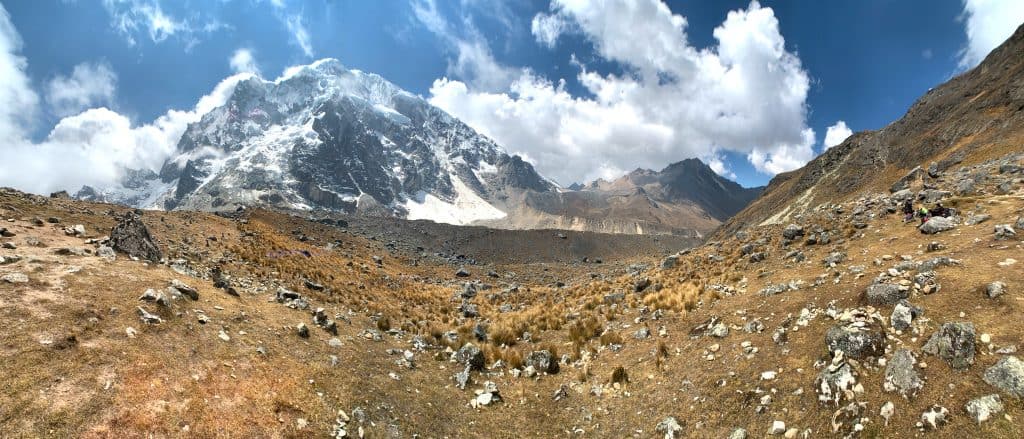
As we began our descent from the Salkantay Pass, just as we thought the hardest part of the day was behind us, the worst possible thing happened: I fell and twisted my ankle. The sharp jolt of pain shot through my leg, and for a brief moment, I feared the trek might be over.
Thankfully, by some strange stroke of foresight—or fate—I had packed an ankle brace. I had injured the same ankle just weeks before, falling off one of those Lime scooters. That minor accident in the city had now become my saving grace in the Andes. Still, every step became more deliberate. Slower. Steven stayed by my side, steady as ever, while my ex had gone on far ahead, unaware of what had happened.
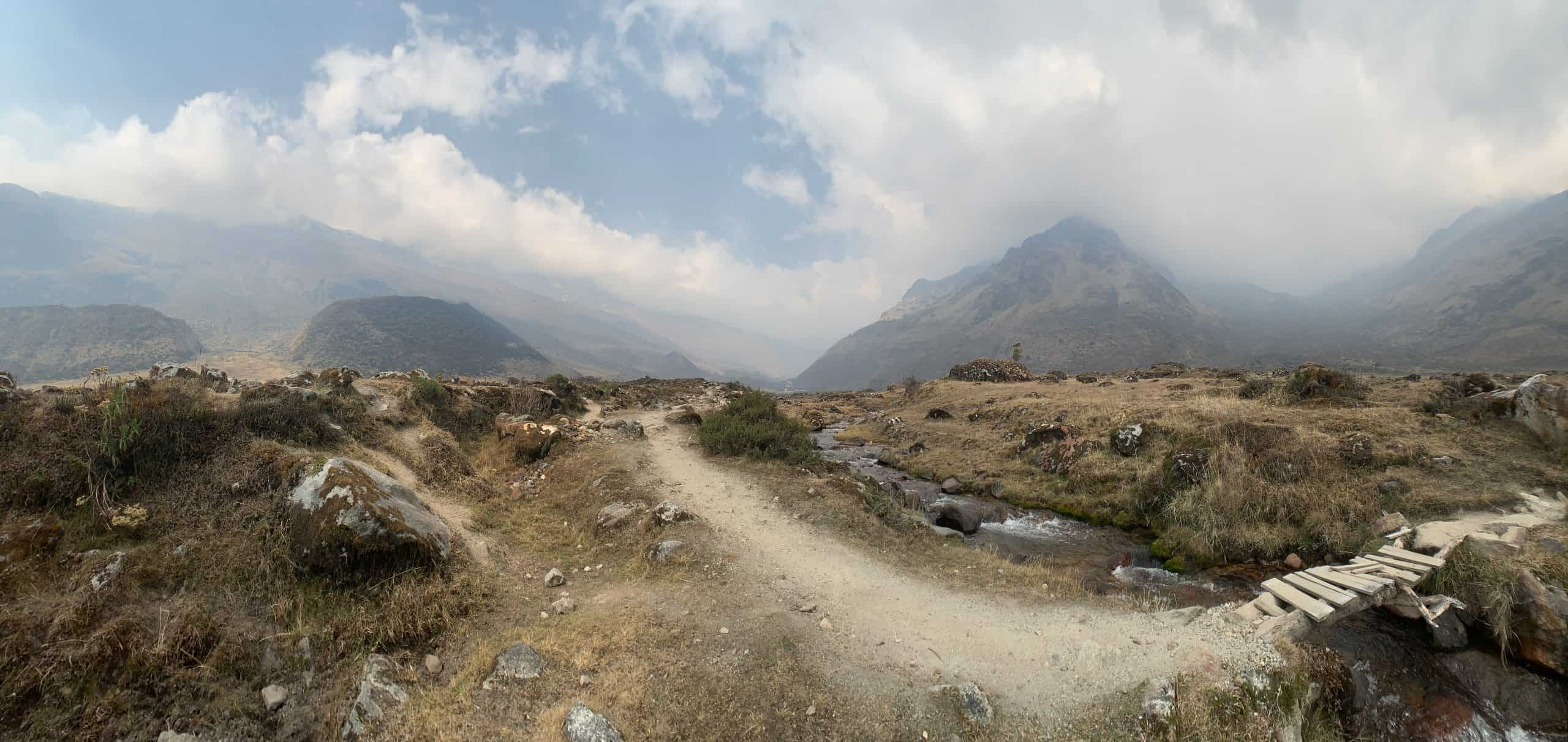
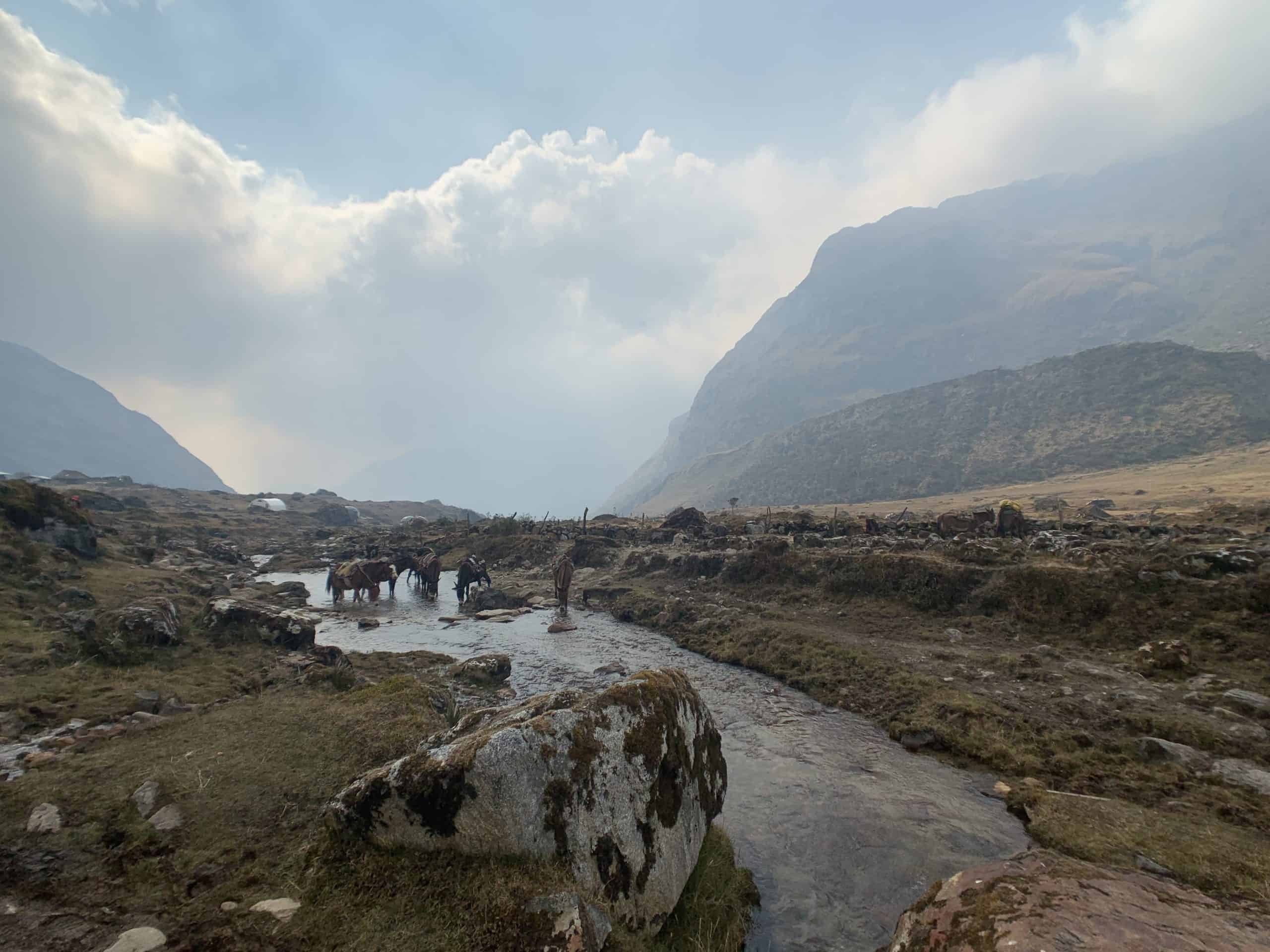
We eventually caught up with him, only to be met with frustration. He was angry, wondering why it had taken us so long. There wasn’t much to say—sometimes pain doesn’t explain itself in words. So we kept walking. The trail turned dusty, the wind dry and brittle as we moved through the highland scrub. But then—everything changed.
At the crest of a hill, the landscape suddenly gave way to a subtle lush, dark green. You could feel the shift instantly, like the earth had exhaled. The air turned warmer, heavier, scented with wet leaves and distant fruit. It was as if we had passed through a threshold into a different world. The Amazon was breathing on us now. Light spilled golden through the canopy, catching the edges of mossy trunks and wild ferns. It felt enchanted.
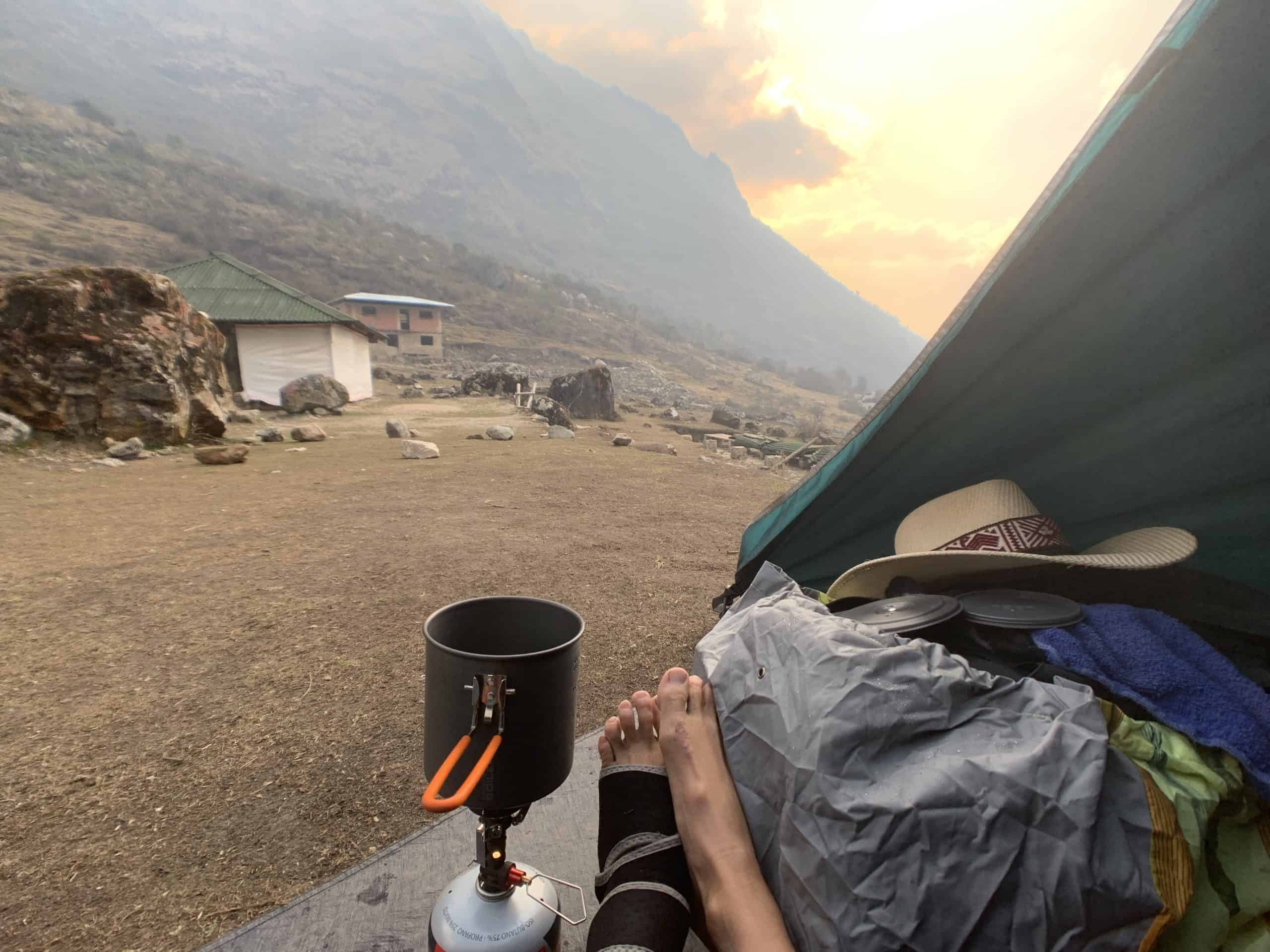
We arrived to Huayracmachay and decided to camp there for the night, drawn in by the softness of the earth and the jungle’s quiet hum. Nearby, we met a Quecha woman who allowed us to pitch our tent on a flat patch of her land. She was a vision of color—wearing a layered skirt that rustled when she walked, woven with deep reds and sky blues, and topped with a beautifully worn Andean hat, its brim casting delicate shadows across her weathered face.
She greeted us without hesitation, speaking in Quechua as well as broken Spanish (better than ours, though), and offered a few refreshments: Coca-Cola, Cusqueña (a beloved Peruvian beer), and a bag of coca leaves—green, bitter, and slightly sweet-smelling. With practiced ease, she showed us how to chew them, placing the leaves in the corner of her mouth like a quiet ritual. Coca leaves have been used by Andean people for centuries—to ease altitude sickness, dull fatigue, and offer gentle focus on long treks. The plant is sacred here, not a drug, but a companion in survival. We followed her lead, slowly chewing as the warmth of the jungle began to settle into our bones.
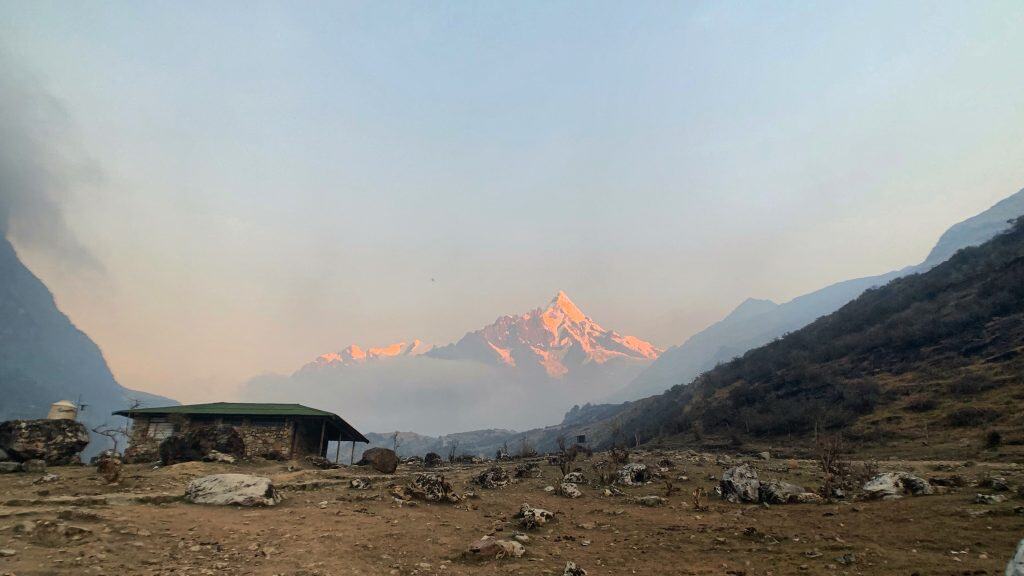
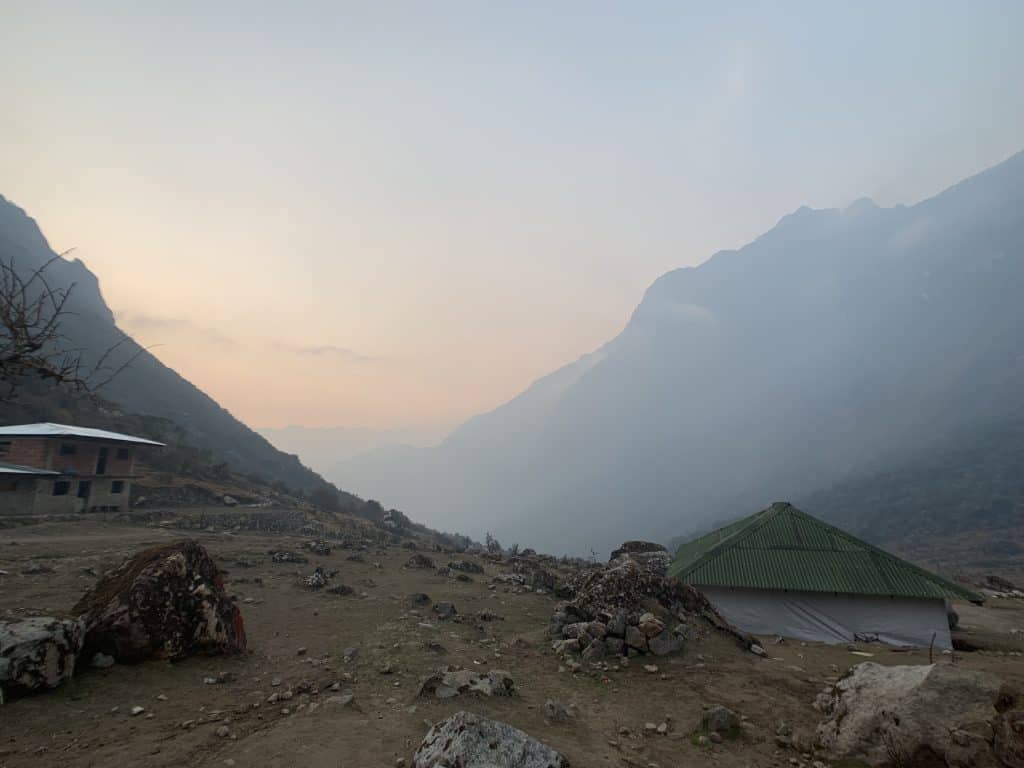
Day 3: Getting Lost but Just Kept Walking
The night before, we realized we were much farther behind than we thought. We were thinking in miles, not kilometers, which made us feel like we were moving fast. But we weren’t. We’d gone much less distance than we thought—and the realization hit hard. We needed to make up for lost time. That quiet miscalculation had left us scrambling. So on Day 3, we packed up our tent with one clear intention: to hike as far as we possibly could.
Almost immediately, the landscape thickened. The world around us turned fully tropical—humid, green, and alive. Vines curled over trees like ribbons. Birds called from unseen branches. Bugs buzzed in rhythmic pulses. It felt like walking through nature’s symphony, but the trail was winding and uncertain, with so many offshoots that we kept second-guessing which direction we were going. More than once, we stopped to look around, unsure if we had taken a wrong turn or if the path had simply dissolved into the forest.
At some point, a small group of locals—Quechua-speaking farmers near the area we had camped—waved us over and offered to make us lunch. They were warm, eager, proud to share a meal in exchange for a little cash. We accepted gratefully. They cooked what they were already preparing for themselves, and we joined them for one of the most unexpectedly delicious meals. The three of us sat alongside four Quechua men and women, eating in near silence, as a few cats climbed up on the table, meowing and pawing at our plates, demanding affection and scraps in equal measure.
At some point, I asked—half-joking—if there was any chance we could find Wi-Fi, just to check where we were. One of the men smiled and pointed to a nearby rock.
“Not Wi-Fi,” he said, “celular.”
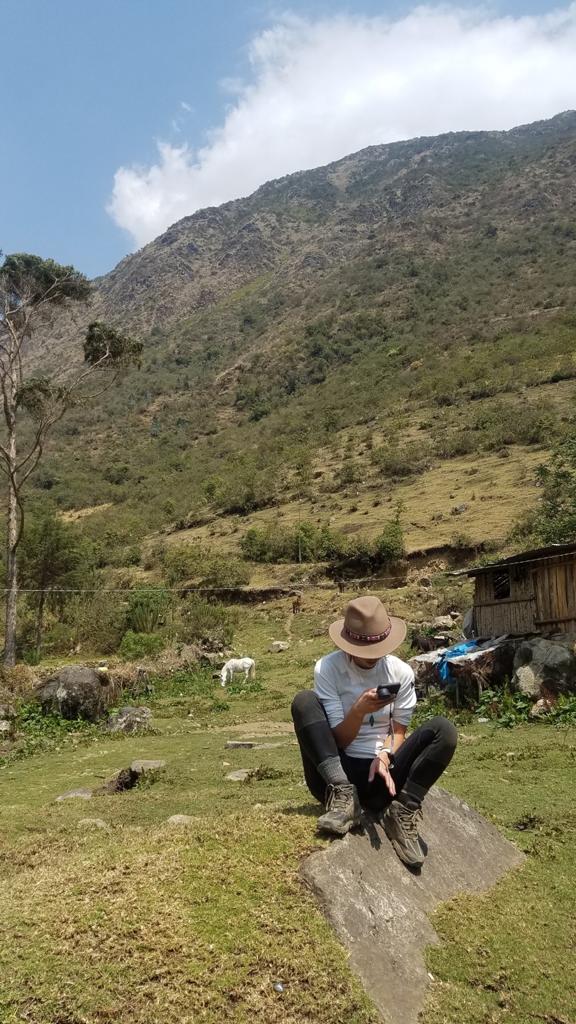
Even though it didn’t really help, I loved that they knew exactly where to find phone service if needed.
So I did it—I walked to the spot they pointed to, phone in hand, hoping for a location dot, a trail marker, any kind of digital breadcrumb to show me where we were. But the signal was faint, flickering, almost taunting. The map barely loaded, freezing mid-refresh. We still had no idea where we were, or how far we had to go.
We turned back to the locals, asking gently, “How much farther?”
They just smiled and said:
“Sigue no más.”
“Just keep going.”
That answer didn’t sit well at first. Keep going? That’s not a measurement. That’s not a map. I wanted details—distance, direction, a sign that we were close or even not close. But they just repeated it again, as if it were enough.
Just keep going.
And in some strange way, it was. That simple phrase became a kind of mantra. Not just for the trail, but for life. We don’t always get maps. Sometimes we just get other people, sitting in silence, sharing a meal, pointing toward the next place with nothing more than trust and repetition.
Keep going.
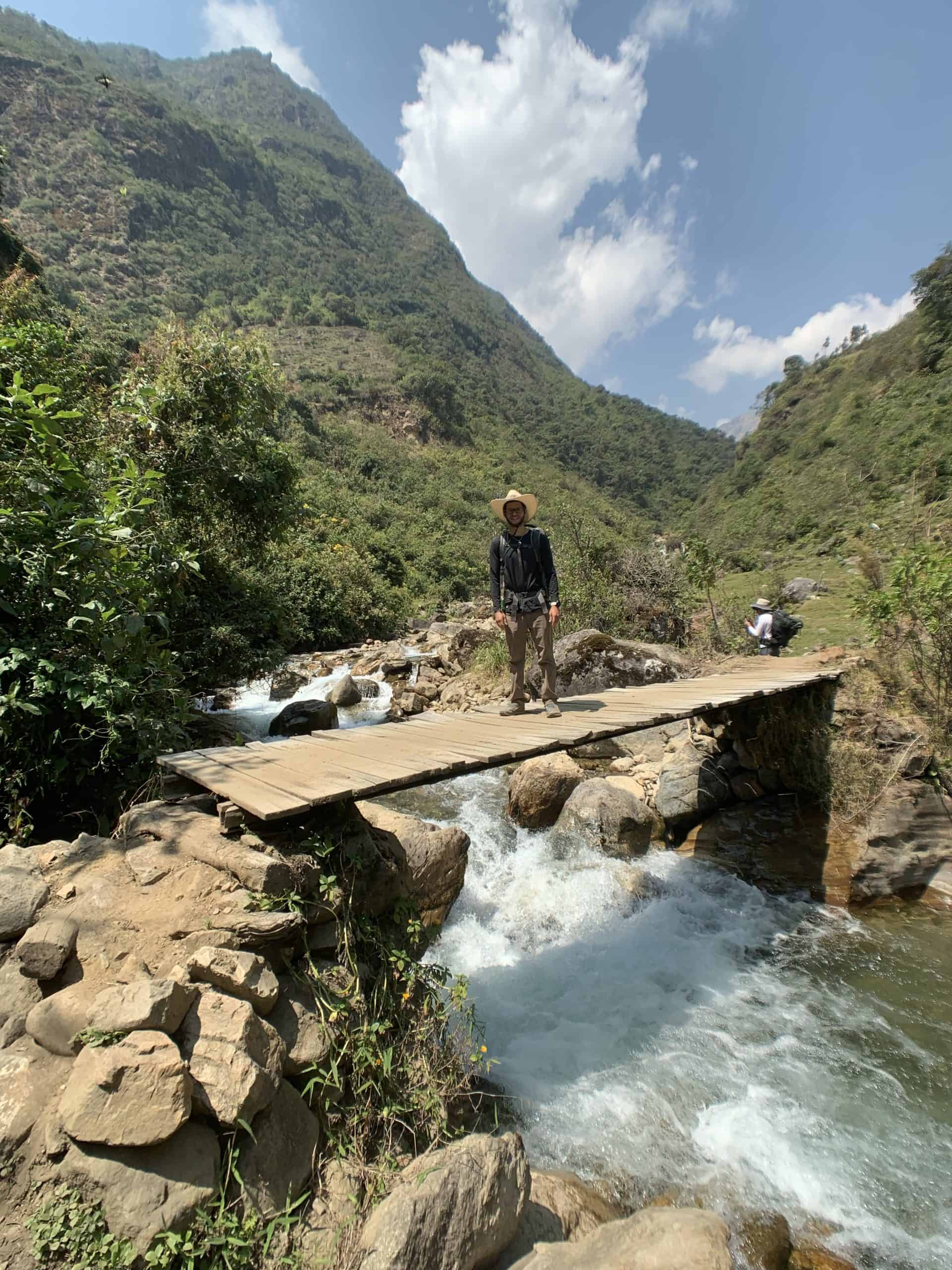
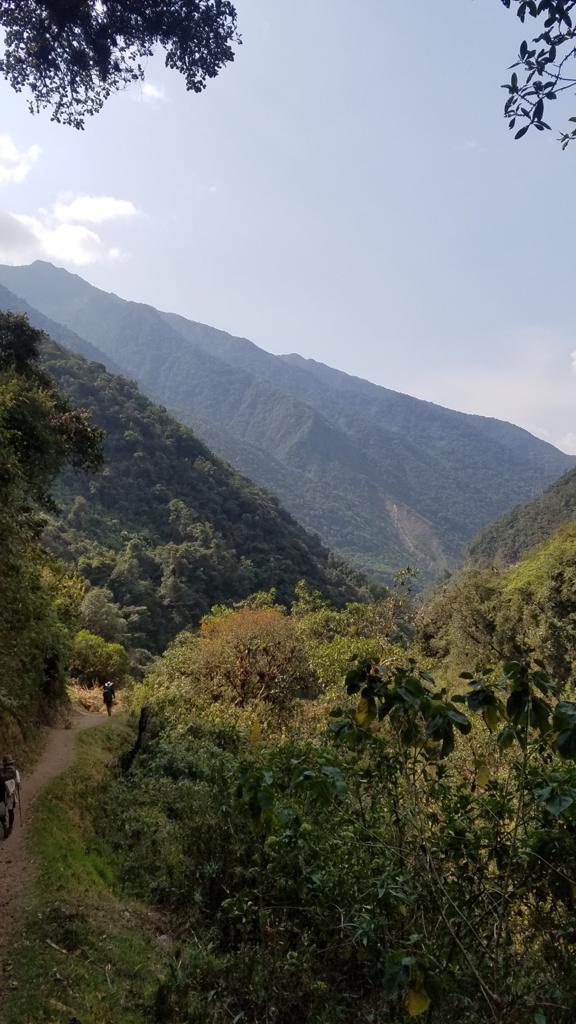
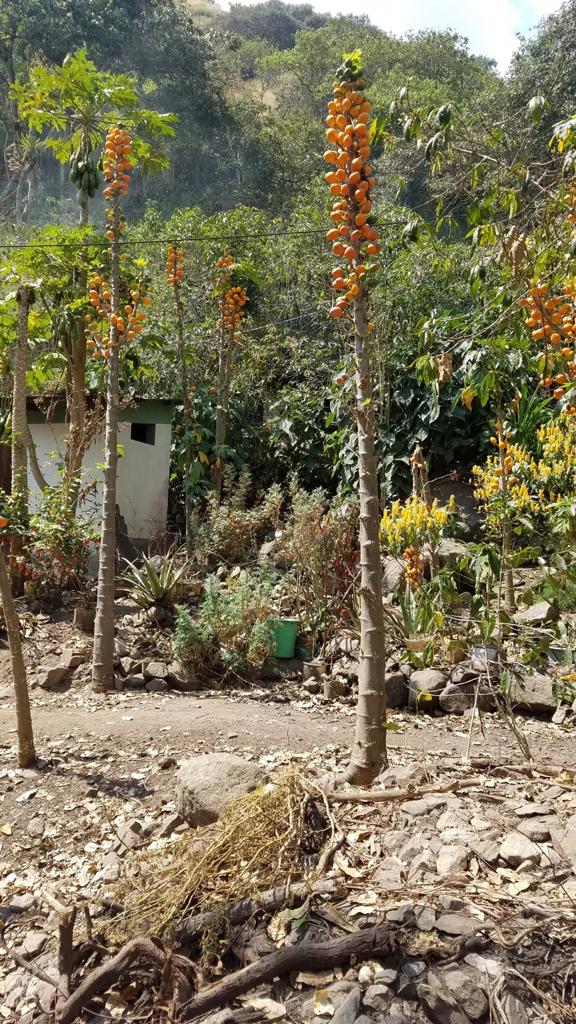
So indeed—we kept going.
We walked through fields of avocados, bananas, and mangoes, winding through what felt like people’s backyards, sometimes quite literally. There were no fences, no signs, no clear trail markers—just the land, and us moving through it. It felt invasive at times, like we were trespassing. But every local we passed would just smile and point us onward, as if to say: you’re exactly where you’re supposed to be.
We saw wildfires in the distance, the smell of smoke blending with jungle air. Crossing rivers, stumbling upon waterfalls, we passed gated luxury resorts that felt worlds apart from our dusty, aching bodies. There were fruits we couldn’t name, landscapes we’d never imagined—and still, we kept walking.
Eventually, we stumbled into a small village near Sahuayacco Beach. By then, we felt like zombies—sunburned, sleep-deprived, dragging our legs like shadows behind us. The town felt eerie, like it had just finished a festival and was still holding its breath. Plastic flags swayed in the wind, and the streets were littered with remnants of celebration. And then came the kids.
Fifteen or so children ran up to us, barefoot and glowing, shouting in proud, sweet English:
“Camping? Camping?”
Their voices were eager, excited—like they had spotted something magical.
We nodded weakly.
“Sí… sí.”
One man we passed was showering with a hose beside a wall. In between rinses, he offered us a patch of his land to sleep. We were grateful, but a little thrown off that he was asking while still mid-shower, water running down his legs. With a little light left in the sky, the instinct to just keep going nudged us forward.
We asked where to go next, and someone pointed down the road.
“Over the bridge,” they said.
And then we got to the bridge.
It was the kind of bridge that makes your stomach clench before your foot even touches it. Narrow, wooden, no railings, water raging just beneath it—so high and so close it almost touched the boards. I remember thinking: There’s no way this is the right way. No paid tour group would ever lead people over this bridge. But this was no tour. This was our path. And trembling, step by step, we crossed it.
Once on the other side, we continued in silence, hiking through the dark for another hour heading into Lucmabamba, barely speaking, our bodies nearly giving out. We were so ready to stop. But we had no idea where we could sleep—until we saw a light.
A single flashlight beam flickering toward us from the darkness.
And I’m not gonna lie—my female brain kicked in hard. We were lost, isolated, and here comes a stranger in the dark with a light. My thoughts jumped to the worst-case scenario—cartels, thieves, anything. But this man… he had just known we were coming. How, I don’t know. Maybe the land speaks to those who listen.
He welcomed us with a smile and offered us space on his coffee farm for just 3 soles each (about $1), and for 6 soles more (about $2), we could have a hot shower.
A hot shower.
And not just any hot shower. The kind that melts off the entire day. We had been in Peru for nearly two weeks at this point and had only known lukewarm water at best. But this little wooden box, with steam curling off our skin and the day washing away into the dirt, felt like luxury beyond luxury. I’ve stayed in fancy hotels, but nothing—not marble tubs or rainfall heads—has ever touched the glory of that moment.
We were covered in the fine, silvery silt left by glacial melt. Dust that shimmers when the sunlight hits it just right. We had carried it with us all day, on our clothes, our skin, in our lungs. And finally, it rinsed away. Whoever invented the hot water system—thank you. Truly.
The man also offered us refreshments. He handed me a pastry called a “Cancún.” I took one bite and immediately bought ten. He laughed so hard he nearly dropped the rest of the bag. We stood there under the stars, tired beyond measure, filthy and full and grateful.
There was a quiet camaraderie in that moment. A sense that we’d made it through something—together. That tomorrow we’d wake up, and if our legs allowed it, we’d reach Aguas Calientes, the last stop before Machu Picchu.
But for now, there was a hot shower, a pastry, and a patch of earth to rest our aching bodies.
And that was enough.
Day 4: Hot Springs, Crazy Car Ride, Hydroelectric Train, Aguas Calientes
We woke to the sound of birdsong and soft light filtering through trees—and to our surprise, the bright red berries of coffee plants surrounding us. The night before had been pitch black, so we had no idea where we were. But as the morning revealed itself, we realized we’d camped on a beautiful, rustic coffee farm that also doubled as a breakfast spot.
The owner, the same man who had welcomed us in the dark, greeted us with kindness and a quiet pride. He led us up to his wooden balcony, where the structure of the house—built from rough timber and years of care—seemed to glow in the sun. And then, as if conjured by a dream, he brought out fresh coffee from his land and made us the most incredible breakfast. It wasn’t just the hunger—it was the warmth, the attention, the comfort of being seen and cared for after being lost in the dark.
After breakfast, we continued on foot for about three more hours until we reached Santa Teresa—a small town that felt oddly empty, like a ghost town paused between moments. We were starving by then and followed a faint, hand-painted sign that simply read:
“Eat here.”
The sign led us to what looked like a once-grand mansion, a restaurant with high archways, old stone, and empty chairs. No one greeted us at first. The silence made us question whether it was open at all—until a man appeared. He turned out to be our server, chef, and possibly the owner all in one. The meal he prepared was outstanding—not just “good for being hungry” but genuinely delicious. I still don’t understand how or why it was so perfect. And the lemonade? Holy shit. It was like drinking joy. Crisp, tart, bright, and wildly refreshing—like it had been made from lemons that grew smiling on trees.
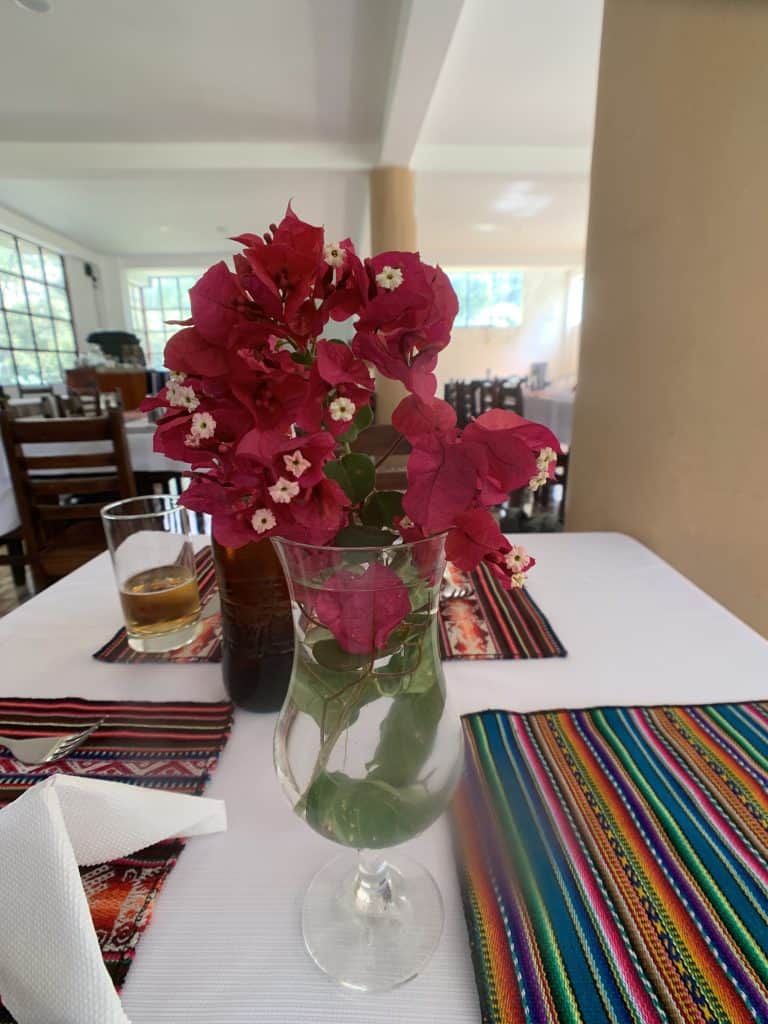
Refueled and slightly delirious, we made our way deeper into town and flagged down a pedicab, which took us to Cocalmayo Hot Springs. For about an hour, we soaked our tired bodies in its warm mineral water—not too hot, but warm enough to relax—and gazed out at epic mountain views. It felt surreal, like our muscles were remembering how to be soft again.
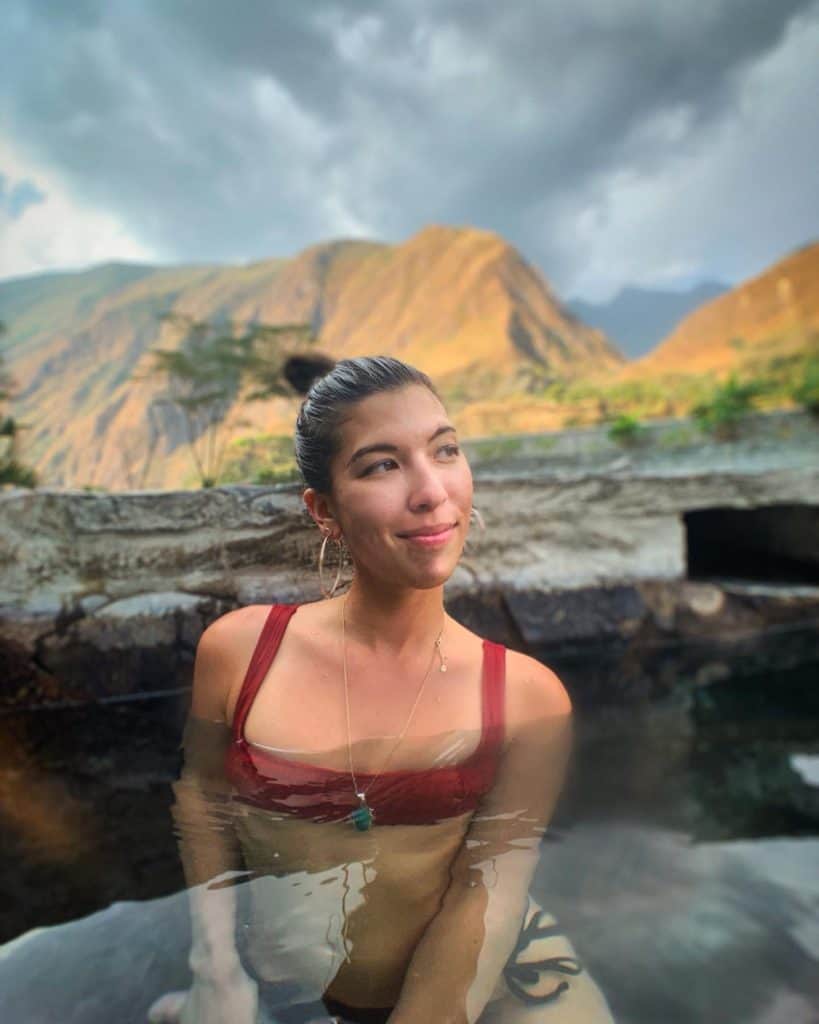
After the soak, we planned to continue hiking toward the Hidroeléctrica train station, where we’d catch a train to Aguas Calientes. But something told us to ask a local first—and thank God we did.
A man who spoke perfect English shook his head and said,
“There’s no way you’ll make the last train. I’ll take you for $40.”
We agreed without hesitation.
His young daughter sat calmly in the front seat as the three of us—Steven, my ex, and I—squeezed into the backseat, crammed tight with our packs, legs folded like origami. We had no idea what was about to happen.
The man grinned and said:
“We’ll take a shortcut.”
That shortcut turned into one of the craziest, most terrifying car rides of my life. We drove along the edge of a mountain road so narrow I couldn’t even look out my window—I was on the cliff side, and it felt like if I leaned an ounce to the left, we’d fall to our deaths. At one point, we were stopped by a rockslide, a full-on avalanche of boulders being cleared by local patrol. But our driver was so determined to get us there, he told the workers:
“I’ll drive over it.”
And he did.
His daughter, completely unfazed, sat in the front reading a book like nothing was happening. Meanwhile, Steven, my ex, and I were exchanging wide-eyed glances, stifling nervous laughter and panic. We didn’t even speak much—just coping through the chaos with chuckles and disbelief.
Somehow, miraculously, we made it to the train station five minutes before departure.
We were shocked. Impressed. Grateful. Terrified. All of it. And honestly, a little giddy. None of this was planned. None of it was manifested. It just happened—because we let go and moved forward anyway.
We gave our driver $100 instead of $40. He deserved it. Without him, we’d probably still be walking in the dark.
The train itself was rickety, shaking and wobbling along the tracks—but it didn’t matter. We were on our way to Aguas Calientes, the town at the base of Machu Picchu. Sweaty and sore, still covered in fine glacial silt, our skin shimmered in the right light—as if we’d carried a bit of the mountains with us.
We pulled into Aguas Calientes just before nightfall, and it felt like a jolt to the system. After days of hiking through silence, jungle, and isolation, the energy of the town hit us like electricity. Though the streets weren’t overcrowded, the air itself buzzed—a strong current of motion and anticipation, as if everyone there was waiting for something. You could hear multiple languages being spoken at once—Spanish, English, German, Japanese—rising and falling in waves. There was music echoing through alleyways, the scent of street food curling through the air, and the sound of wheeled suitcases bumping over cobblestone.
Aguas Calientes isn’t a quiet mountain village—it’s a bustling town tucked tightly into the folds of steep green cliffs, built almost entirely around one thing: Machu Picchu. It’s the last threshold before the sacred site. A meeting place for pilgrims, tourists, hikers, and wanderers alike. It felt surreal to be there after everything—the falls, the laughter, the bridges, the moments we weren’t sure we’d make it.
We checked into our hostel—Super Tramp—a place built for backpackers and dreamers, layered with murals and well-worn couches. We put our bags in lockers, took much-needed showers, and dropped our dusty, sweat-soaked clothes off with a laundry lady across the street, who smiled and said they’d be ready in a couple hours.
Then we wandered the town. Still absorbing the contrast of being surrounded by shops, cafes, bars, signs, and people again. Everything felt a bit unreal, like we were still half in the jungle and half in a dream.
My ex decided to turn in early, his body and spirit ready to rest. But Steven and I stayed up. We picked up our laundry, warm and folded, and grabbed a simple dinner at our hostel’s rooftop—a casual meal under the hum of string lights, surrounded by travelers clinking glasses and sharing stories from the trail.
And we were quiet—not from exhaustion anymore, but from anticipation.
Tomorrow, we’d stand before Machu Picchu.
The end. The beginning. The reason we came.
Day 5: Machu Picchu and a Big Lesson in Life
I’m so glad we bought the bus tickets.
There’s an option to walk to Machu Picchu from Aguas Calientes, but as our bus zigzagged through switchback after switchback, I knew we had made the right choice. It was a rough ride—tight curves, sharp drops—but we were thankful to have a moment of stillness before entering the most anticipated moment of our journey.
We arrived early in the morning, but it was already chaotic at the gate. Loud. Crowded. I felt inebriated, not from anything I had consumed, but from the sheer overwhelm. I ducked into the bathroom to catch my breath, hoping for a quiet moment—but even there, the noise continued. Girls were putting on makeup, spraying their hair, smacking their lips in the mirror. It felt surreal. I felt like I was drowning in performance, suffocating in a space that should’ve felt sacred.
When we showed our tickets, the woman at the gate looked—depressed. Like her spirit had been worn thin by the endless procession of bodies coming through. And for some reason, that moment stayed with me. Her expression hit me harder than I expected. A reminder that this site—once a sacred city of stone and sky—had become a backdrop for selfies and itineraries. A place of wonder turned product.
We entered, and began our hike through the ancient city. We were grateful for our acclimation—it allowed us to move quickly, even playfully, through the trail, while others struggled with the altitude. But still, it all felt rushed. Like we were running through something holy, afraid we’d miss our window.
And then we reached the viewpoint of Huayna Picchu—the iconic peak you always see in photos—and something shifted. There, standing before the full view of Machu Picchu, with the mist slowly rising around it and the mountains breathing their ancient breath, I looked around and saw people changing into heels for the perfect photo.
It hit me.
Is this why we’re here? For a picture?
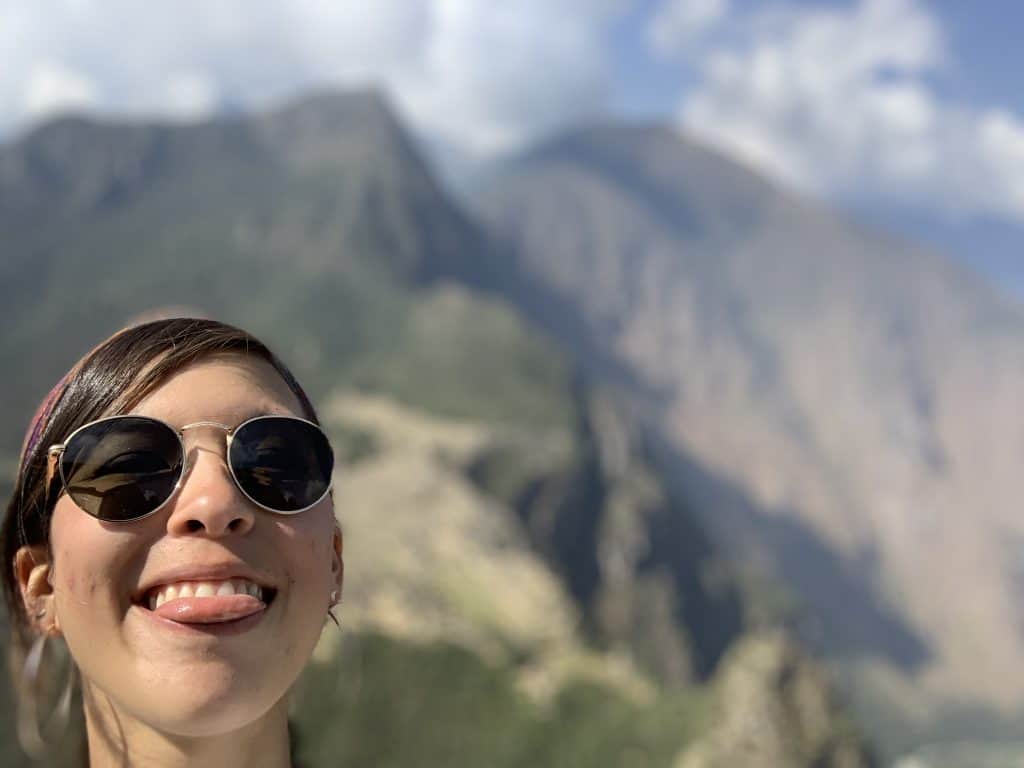
That moment cracked something open in me. I had spent so much of my life capturing everything—every sunset, every moment, every magic hour—trying to bottle beauty before it slipped away. But in that moment, I didn’t want to capture anything. I wanted to let it capture me.
I had to take a silly photo,
but then I had stopped taking pictures.
I stood still.
I let the scene impress itself on my soul, not my lens.
It might not help my blog, I know. Part of me, even now, wishes I had more photos to show you. But what I gained that day was something else entirely. I learned what it means to truly witness something—not through a screen, but through presence. Through breath. Though these words. Through being.
We descended to explore more of the Machu Picchu ruins, but I couldn’t shake the feeling in my gut. It was too loud. Too crowded. Like Disney World with sacred stones. I wanted silence, reverence and to hear the wind tell stories through the walls. But the noise drowned it out.
Machu Picchu itself is extraordinary—a marvel of architecture, astronomy, and spirit. Built by the Incas in the 15th century and later abandoned, it remained hidden for centuries, tucked high in the mountains like a secret between the earth and sky. There are stories carved into those stones. Mathematics and myth. Ceremonies and rain. But that day, I couldn’t hear them. I wanted to—but the voices of the past felt muffled under the footsteps of the present.
When we returned to Aguas Calientes, the three of us dropped our shoulders, our expectations, and reflected quietly. We smirked at the irony: the journey had been magnificent. The destination, too—but in a different way. A sobering way. It reminded us that beauty is not just about where you arrive, but how you arrive, and who you become along the way.
We grabbed our bags from the hostel locker and boarded the train back to Cusco. This train was a world apart from the one we’d taken from Hidroeléctrica the day before—smoother, quieter, and more comfortable. It felt like the first time we could truly exhale. The car gently rocked through the mountains, windows framing rivers and forest like a slow-moving film. And for a moment, we were still—almost reverent.
On that ride, we met Susy.
She didn’t speak English, and we didn’t speak fluent Spanish, but through smiles, hand gestures, and shared glances, we found a way to communicate. She was kind, curious, warm—the way many strangers had been on this trail. Our conversation wasn’t built on words but on something older. Humanity.
It reminded me that not all communication is language. Sometimes it’s a smile, a warm meal, a place to rest, or a shared seat on a train. And maybe that’s the real magic of this journey—not the ruins, not the photo, not even the summit—but the moments of unexpected connection. The people who met us in our exhaustion and showed us something real.
Conclusion: More Than a Trail
So this is how my five-day journey to Machu Picchu ends—not with a perfect photo or a scripted moment, but with mud on my shoes, cocoa leaves in my pocket, and the quiet ache of a soul that has seen something it can’t explain.
This trail gave me more than beauty. It gave me contrast. Solitude and chaos. Stillness and movement. Wonder and noise. It gave me laughter, fear, silence, and the realization that sometimes letting go leads to the richest stories of all.
Machu Picchu was the reason. But the Salkantay Trail in Peru was the transformation.
And that, I’ll carry with me.


